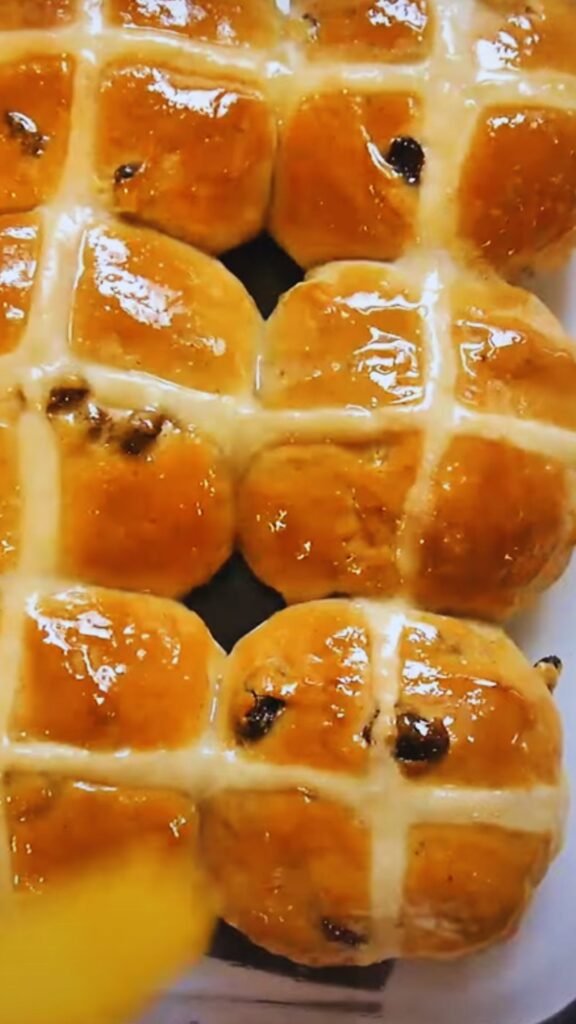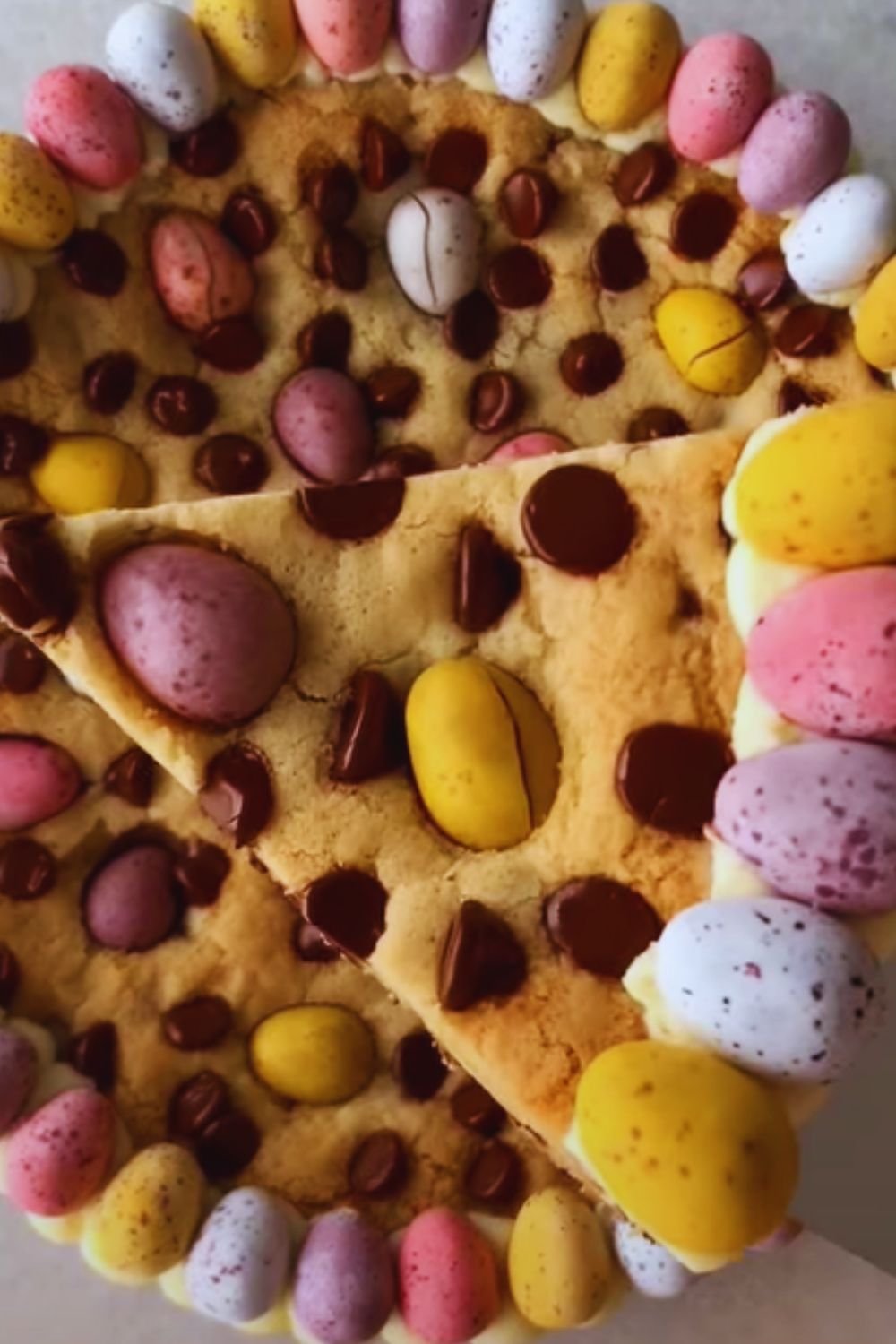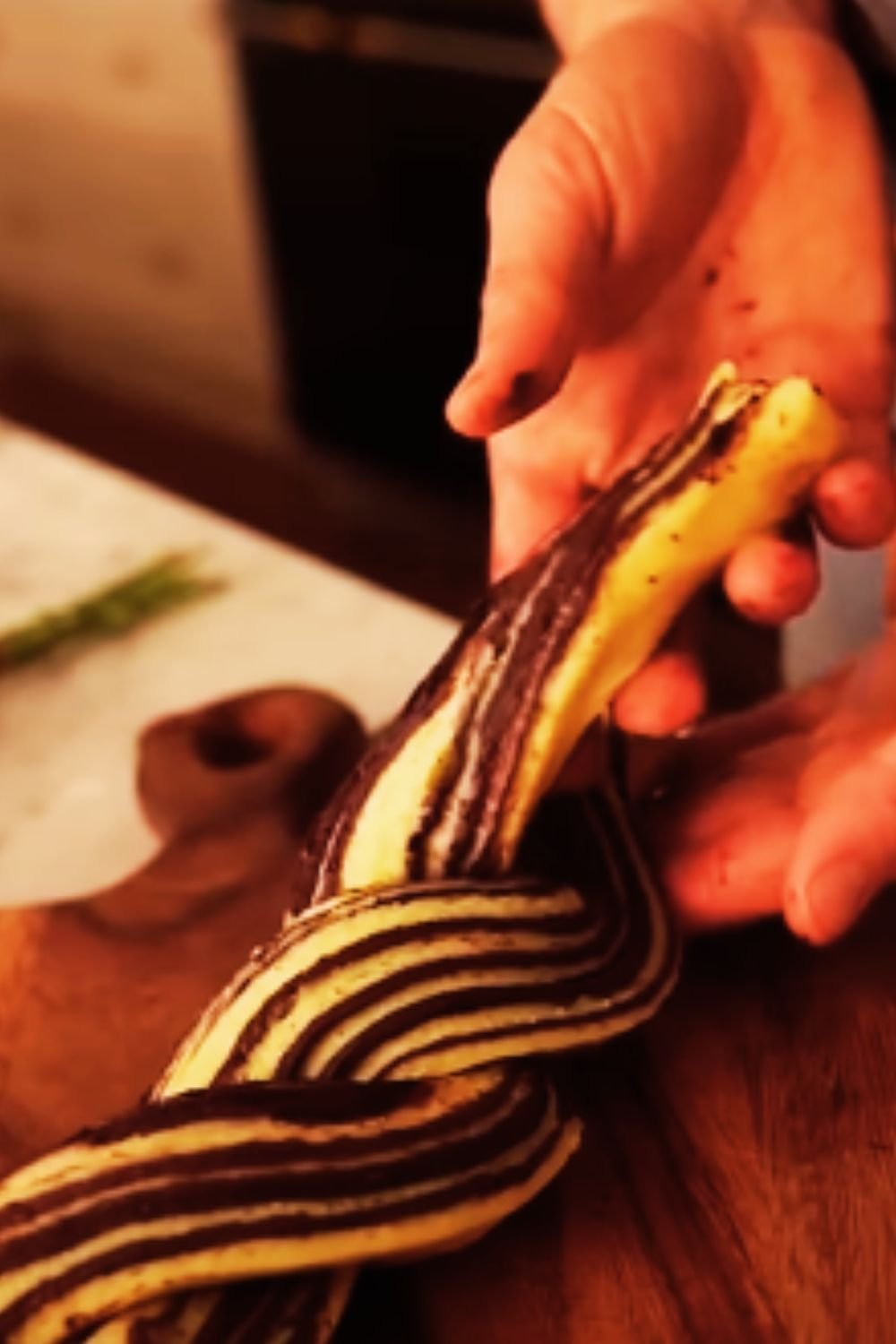There’s something magical about the aroma of freshly baked hot cross buns wafting through the kitchen. Every Easter, I find myself eagerly anticipating that first bite of a warm, spiced bun studded with plump fruit and marked with that iconic cross on top. After years of testing and tweaking, I’ve finally perfected a recipe that produces the fluffiest, most delicious hot cross buns you’ll ever taste.
These traditional sweet rolls have been an Easter staple for centuries, but trust me when I say they’re too good to enjoy just once a year! With their soft, pillowy texture, aromatic spices, and perfect balance of sweetness, these buns are worth making any time you crave something special for breakfast or afternoon tea.
What Makes These Hot Cross Buns Special?
What sets this recipe apart is the careful attention to detail in the dough preparation. I’ve discovered that using the tangzhong method—a Japanese technique involving cooking a portion of the flour with liquid to create a paste—results in exceptionally soft, fluffy buns that stay fresh longer. Combined with the perfect blend of warm spices and the right amount of kneading, these little beauties rise beautifully and maintain their pillowy texture for days.
Ingredients You’ll Need
For the Tangzhong (Flour Paste):
- 3 tablespoons (25g) bread flour
- ½ cup (120ml) whole milk
For the Dough:
- 4 cups (500g) bread flour
- ⅓ cup (67g) granulated sugar
- 2¼ teaspoons (7g or 1 packet) instant yeast
- 1 teaspoon salt
- 1½ teaspoons ground cinnamon
- ½ teaspoon ground nutmeg
- ¼ teaspoon ground allspice
- ¼ teaspoon ground cardamom (optional but recommended)
- Zest of 1 orange
- ¼ cup (60g) unsalted butter, softened
- 2 large eggs, room temperature
- ½ cup (120ml) warm whole milk (in addition to what’s used in the tangzhong)
- 1 tablespoon vanilla extract
For the Fruit Mix:
- ¾ cup (120g) mixed dried fruit (raisins, currants, cranberries)
- ¼ cup (40g) candied orange peel, finely chopped
- 2 tablespoons orange juice
For the Crosses:
- ½ cup (65g) all-purpose flour
- 5-6 tablespoons water
- 1 teaspoon vegetable oil
For the Glaze:
- ¼ cup (50g) granulated sugar
- 3 tablespoons water
- ½ teaspoon vanilla extract (optional)
- ¼ teaspoon ground cinnamon (optional)
Equipment Needed
- Stand mixer with dough hook (or strong arms for kneading!)
- Large mixing bowl
- Small saucepan
- Measuring cups and spoons
- Thermometer (optional but helpful)
- 9×13 inch baking pan
- Pastry brush
- Piping bag or zip-top bag
- Cooling rack

Detailed Step-by-Step Instructions
Prepare the Tangzhong
- In a small saucepan, whisk together the 3 tablespoons of bread flour and ½ cup milk until no lumps remain.
- Cook over medium-low heat, whisking constantly, until the mixture thickens to a paste (around 160°F/71°C if using a thermometer).
- Remove from heat, cover with plastic wrap directly on the surface to prevent skin formation, and let cool to room temperature.
Prepare the Fruit Mix
- Combine the dried fruits and candied peel in a small bowl.
- Pour the orange juice over the fruit mixture, stir well, and let soak while preparing the dough. This rehydrates the fruit and infuses it with flavor.
Make the Dough
- In the bowl of a stand mixer fitted with the dough hook, combine the flour, sugar, yeast, salt, cinnamon, nutmeg, allspice, cardamom, and orange zest. Mix briefly to combine.
- Add the cooled tangzhong, softened butter, eggs, warm milk, and vanilla extract.
- Mix on low speed for 2 minutes until ingredients are incorporated.
- Increase to medium speed and knead for 8-10 minutes until the dough is smooth, elastic, and passes the windowpane test (when stretched, it should be thin enough to see light through without tearing).
- Drain any excess liquid from the soaked fruit mixture, then add the fruits to the dough.
- Mix on low speed just until the fruits are evenly distributed throughout the dough, about 1 minute.
First Rise
- Transfer the dough to a lightly greased bowl, cover with plastic wrap or a damp kitchen towel, and let rise in a warm place until doubled in size, about 1-1½ hours.
- The ideal temperature for rising is around 75-78°F (24-26°C). If your kitchen is cooler, you can create a warm environment by placing the bowl in a turned-off oven with just the light on.
Shape the Buns
- Once doubled, gently punch down the dough to release air bubbles.
- Turn out onto a lightly floured surface and divide into 15 equal pieces (about 80-85g each for perfectly sized buns).
- To shape each bun, take a piece of dough and pull the edges toward the center, creating tension on the surface. Flip over so the seam side is down, then roll between your palms to form a smooth ball.
- Place buns in a greased 9×13 inch baking pan, arranged in five rows of three, leaving a little space between each for rising.
Second Rise
- Cover loosely with plastic wrap or a damp kitchen towel and let rise again until the buns have puffed up and are touching each other, about 45-60 minutes.
- About 20 minutes before the end of the rising time, preheat your oven to 350°F (175°C).
Make the Crosses
- Mix the flour, water, and oil in a small bowl until you have a thick paste that can be piped but isn’t too runny.
- Transfer to a piping bag fitted with a small round tip or a zip-top bag with a corner snipped off.
- When the buns have finished their second rise, pipe the flour paste in straight lines across the rows of buns, creating crosses on each one.
Bake
- Bake in the preheated oven for 22-25 minutes, until the buns are golden brown and sound hollow when tapped on the bottom.
- If the tops are browning too quickly, loosely cover with aluminum foil halfway through baking.
Prepare the Glaze
- While the buns are baking, combine the sugar and water in a small saucepan.
- Bring to a simmer over medium heat, stirring until the sugar dissolves completely.
- Let simmer for 1-2 minutes until slightly thickened.
- Remove from heat and stir in the vanilla extract and cinnamon if using.
Finish the Buns
- As soon as the buns come out of the oven, brush the warm glaze all over the tops.
- Let the buns cool in the pan for 10 minutes before transferring to a wire rack to cool completely.

Pro Tips for Perfect Hot Cross Buns
| Problem | Cause | Solution |
|---|---|---|
| Dense, heavy buns | Insufficient kneading or rising | Knead until dough passes windowpane test; ensure proper rising temperature |
| Dry buns | Overbaking or incorrect flour-to-liquid ratio | Use tangzhong method; check doneness 5 minutes before stated time |
| Crosses disappear during baking | Too thin flour paste | Make paste thicker; pipe crosses deeper into dough |
| Uneven distribution of fruit | Not properly incorporated or too much fruit | Drain fruit well; fold in gently but thoroughly |
| Buns stuck together | Too close placement or overproofing | Space properly; don’t over-proof during second rise |
| Pale crust | Low sugar content or low baking temperature | Apply egg wash before baking; ensure oven is fully preheated |
| Crosses too hard | Too much flour in paste | Add more water to cross mixture; include a little oil |
| Buns stale quickly | Inadequate fat or missing tangzhong | Don’t skip tangzhong; store properly in airtight container |
Variation Ideas
| Variation | Additional/Substitute Ingredients | Special Instructions |
|---|---|---|
| Chocolate Chip | Replace dried fruit with 3/4 cup chocolate chips | Fold in gently after main kneading to prevent melting |
| Apple-Cinnamon | Add 1 cup diced dried apples; increase cinnamon to 2 tsp | Soak dried apples in apple juice instead of orange juice |
| Lemon-Blueberry | Replace orange zest with lemon; use 3/4 cup dried blueberries | Add 1 tbsp lemon juice to the dough; use lemon juice in glaze |
| Cardamom-Pistachio | Increase cardamom to 1 tsp; add 1/3 cup chopped pistachios | Toast pistachios before adding; reduce other spices slightly |
| Traditional | Use only currants and candied peel | Add 1/2 tsp mixed spice for authentic British flavor |
| Sourdough | Replace 1/4 cup flour & instant yeast with 1 cup active sourdough starter | Increase first rise time to 3-4 hours |
Storage and Make-Ahead Tips
These hot cross buns stay fresh for 2-3 days when stored in an airtight container at room temperature. For longer storage, freeze them for up to 3 months. Here’s my method for freezing and reheating:
- Cool buns completely.
- Wrap individually in plastic wrap, then place in a freezer-safe bag.
- Label with the date and freeze.
- To reheat, thaw overnight in the refrigerator, then warm in a 300°F (150°C) oven for 5-10 minutes.
You can also prepare the dough ahead of time:
- After shaping the buns, place them in the baking pan, cover tightly with plastic wrap, and refrigerate overnight.
- The next morning, let them sit at room temperature for about an hour before piping on the crosses and baking.
Serving Suggestions
Hot cross buns are traditionally enjoyed at breakfast or afternoon tea, but they’re versatile enough for many occasions:
- Split and toasted with a generous spread of butter for breakfast
- Served alongside a cheese board (particularly nice with a sharp cheddar)
- Used as the base for bread pudding
- Split and filled with whipped cream and strawberries for a simple dessert
- Toasted and spread with cream cheese and honey

Troubleshooting Common Issues
Why are my buns dense instead of fluffy?
There are several potential causes:
- The dough wasn’t kneaded long enough to develop gluten
- The rising environment was too cool
- The yeast was old or inactive
- The dough was overloaded with fruit
Solution: Make sure to knead until the dough passes the windowpane test, use fresh yeast, and provide a warm environment for rising (75-78°F/24-26°C is ideal).
Why didn’t my crosses stay white?
If your crosses turned brown, the flour paste might have been too thin. Make sure your paste is thick enough to hold its shape. Adding a small amount of oil to the paste can also help prevent it from being absorbed into the dough during baking.
Why are my buns dry?
Hot cross buns can dry out if they’re overbaked or if the dough doesn’t contain enough fat or moisture. The tangzhong method helps significantly with moisture retention, so don’t skip this step. Also, be sure to apply the sugar glaze immediately after baking.
Can I make these without a stand mixer?
Absolutely! You can knead the dough by hand, though it will require about 12-15 minutes of kneading to achieve the same level of gluten development. The dough should be smooth, elastic, and pass the windowpane test before you add the fruits.
The Science Behind Soft Buns
The tangzhong method is truly a game-changer for creating ultra-soft bread that stays fresh longer. Here’s why it works:
When you cook a portion of the flour with liquid, the starch granules in the flour gelatinize, absorbing more liquid than they would in a traditional dough. This means:
- The dough can hold more moisture without becoming sticky or difficult to handle
- The gelatinized starch strengthens the gluten network
- The extra moisture turns to steam during baking, creating a lighter texture
- The higher moisture content prevents the buns from drying out quickly
This technique originated in Japan for making milk bread but works wonderfully for enriched doughs like hot cross buns.
Frequently Asked Questions
Q: Can I use active dry yeast instead of instant yeast?
Yes, you can substitute active dry yeast for instant yeast. Use the same amount, but you’ll need to activate it first: dissolve the yeast in the warm milk with a pinch of sugar and let it sit for 5-10 minutes until foamy before adding to the dough.
Q: Can I make these hot cross buns dairy-free?
Absolutely! Replace the milk with almond milk or oat milk and substitute the butter with a plant-based butter. The texture might be slightly different, but they’ll still be delicious.
Q: Can I make hot cross buns without eggs?
Yes, you can replace each egg with one of these substitutes:
- 1/4 cup unsweetened applesauce
- 1/4 cup mashed banana
- 3 tablespoons aquafaba (the liquid from canned chickpeas)
Q: What if I don’t have all the spices listed?
If you don’t have the exact spices, you can use 2 teaspoons of mixed spice or pumpkin pie spice as a substitute for all the individual spices.
Q: Can I make mini hot cross buns?
Yes! Divide the dough into 24 smaller pieces instead of 15. Reduce the baking time to about 18-20 minutes, checking for doneness.
Q: Why do my buns crack on the sides when baking?
Some slight cracking is normal, but excessive cracking usually indicates that the dough formed a skin during the second rise. Make sure to cover the buns properly during rising to prevent this.
Q: Can I use bread flour if I want extra chewy buns?
The recipe already calls for bread flour, which helps create structure in the dough. If you prefer a more tender crumb, you can substitute up to half of the bread flour with all-purpose flour.
Q: How do I know when the buns are properly kneaded?
The dough should be smooth, elastic, and pass the windowpane test: take a small piece of dough and gently stretch it between your fingers. It should stretch thin enough to see light through without tearing.
A Brief History of Hot Cross Buns
Hot cross buns have a rich history dating back to the 12th century. According to one popular story, they were originally created by a monk at St. Albans Abbey in England, who marked them with a cross and distributed them to the poor on Good Friday.
Over the centuries, these spiced, sweet buns became firmly associated with Easter traditions. In the 16th century, during the reign of Elizabeth I, the London Clerk of Markets issued a decree forbidding the sale of hot cross buns except on Good Friday, Christmas, and for burials.
This restriction only made them more popular, and people began baking them at home. The cross on top, now typically made from flour paste, symbolizes the crucifixion, while the spices represent the spices used to embalm Jesus.
Today, these delicious buns are enjoyed worldwide, often appearing in bakeries weeks before Easter. While they maintain their religious symbolism for many, they’ve also become beloved simply for their wonderful flavor and texture.
By following this recipe, you’re participating in a centuries-old tradition—with the modern improvement of the tangzhong method for the fluffiest possible results!
I hope you enjoy making and eating these incredibly fluffy hot cross buns! There’s nothing quite like pulling apart a warm bun fresh from the oven and watching the steam rise as you spread it with butter. If you try this recipe, I’d love to hear how it turned out for you!


